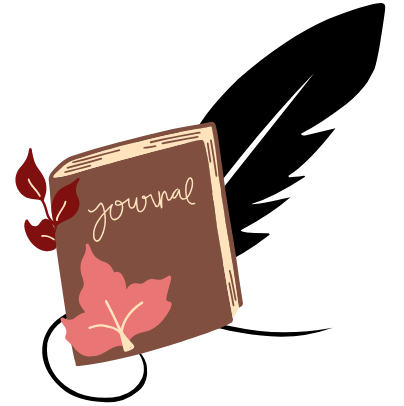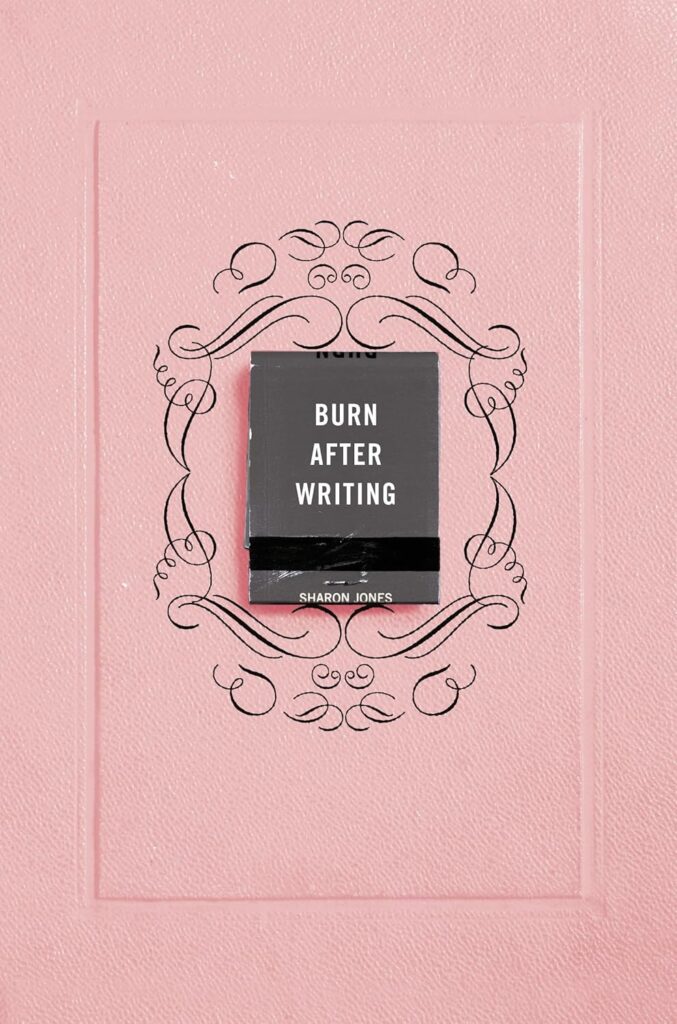This unique journaling concept has taken the self-reflection world by storm, promising a private space for raw honesty and personal growth. As someone who’s explored various journaling methods, I was naturally curious about this provocative approach to self-discovery.
Just a heads-up: This post contains affiliate links, meaning if you click and make a purchase, I may earn a small commission—at no extra cost to you. I only recommend products I genuinely believe will enhance your journaling journey.
Now, let’s dive into my review of Burn After Writing and discover what makes this journal so unique!
What Is Burn After Writing?
Burn After Writing is more than just a journal – it’s a guided introspection experience created by Sharon Jones. The concept is simple yet powerful: answer thought-provoking questions about your life, your past, your wants, and your fears – then destroy the evidence.
This destruction aspect sets it apart from traditional journaling, encouraging uninhibited honesty and emotional release.
The Physical Product: Design and Quality
When I first held the Burn After Writing journal, it’s sleek, minimalist design immediately caught my eye. The cover features a striking match graphic that perfectly encapsulates the journal’s concept.
The paper quality is impressive, allowing for smooth writing without bleeding through – a crucial factor for those who prefer to use various writing instruments.
The journal’s compact size makes it highly portable, fitting comfortably in most bags. This portability is a significant advantage, as inspiration (or the need for emotional release) can strike at any moment.
Content and Structure: Exploring Your Psyche
Opening the journal, you’re greeted with an introduction that sets the tone for the experience ahead. The prompts are thoughtfully divided into sections, each exploring different aspects of your life and psyche.
The Past
This section encourages reflection on childhood memories and formative experiences. Questions might include:
- What’s your earliest memory?
- Who was your childhood hero?
- What’s a moment from your past you wish you could relive?
The Present
Here, you’ll explore current relationships, values, and daily life. Sample prompts:
- What’s the most challenging aspect of your life right now?
- Who do you trust the most, and why?
- What’s a small pleasure you enjoy every day?
The Future
This category prompts contemplation of goals, fears, and aspirations:
- Where do you see yourself in 5 years?
- What’s your biggest fear about the future?
- If you could guarantee one thing for your future self, what would it be?
Identity
These questions challenge you to examine who you are and who you want to be:
- What three words best describe you?
- If you could change one thing about yourself, what would it be?
- What’s a belief you hold that others might find controversial?
Relationships
This section examines connections with family, friends, and romantic partners:
- Who’s the most important person in your life right now?
- What’s a relationship you wish you could improve?
- Have you ever been in love? How did it feel?
The questions range from lighthearted (“What’s your go-to karaoke song?”) to deeply personal (“What’s your biggest regret?”). This variety keeps the journaling experience engaging and prevents it from feeling monotonous or overwhelming.
The Writing Experience: Unleashing Honesty and Emotion
As I began working through the prompts, I was surprised by the depth of emotion and honesty they evoked.
The promise of eventual destruction creates a unique psychological space where you feel safe to be truly vulnerable. It’s similar to having a conversation with your most trusted confidant – yourself.
Some prompts made me laugh out loud, others brought tears to my eyes, and a few even made me confront aspects of myself I’d been avoiding. The experience was cathartic, enlightening, and at times, challenging.
I found myself writing about childhood memories I hadn’t thought about in years, examining my current relationships with newfound clarity, and daring to dream big about my future.
The journal became a safe space for me to express fears and insecurities I’d never voiced aloud, as well as hopes and ambitions I’d been too afraid to acknowledge.
One particularly powerful prompt asked me to write a letter to my younger self. As I penned words of encouragement and wisdom to my past self, I realized how much I’ve grown and learned over the years.
It was a surprisingly emotional experience that left me feeling both nostalgic and proud.
Another section that resonated strongly with me focused on personal values. It challenged me to identify my core beliefs and examine how well my current life aligns with them.
This exercise sparked some serious introspection and even led me to make some changes in my daily routines to better reflect my true priorities.
The Burning Question: To Burn or Not to Burn?
The most controversial aspect of this journal is, of course, the suggestion to destroy it after completion. This concept raises several important questions:
- Does destruction enhance the therapeutic value?
- What about preserving memories and tracking personal growth?
- Is it environmentally responsible to burn paper?
Ultimately, the decision to burn is a personal one. Some users report feeling an immense sense of release and closure after destroying their journals.
Others prefer to keep them as a record of their journey.
I found that even the option of destruction added a layer of freedom to the writing process, knowing that I could choose to keep my thoughts private forever if I wished.
This knowledge allowed me to be more honest and vulnerable in my responses than I might have been otherwise.
After much deliberation, I decided to keep my completed journal. While I understand the appeal of the symbolic release that burning provides, I found value in being able to look back on my responses and track my personal growth over time.
However, I’ve stored it in a secure location to maintain the privacy of my innermost thoughts.
Psychological Benefits: More Than Just Writing
The Burn After Writing journal uses several psychological principles that contribute to it’s effectiveness:
Catharsis
The act of expressing emotions freely can be incredibly therapeutic. By providing a safe space to explore and release pent-up feelings, the journal offers a form of emotional catharsis that can lead to reduced stress and improved mental well-being.
Self-reflection
Regular introspection leads to increased self-awareness and personal growth. The journal’s prompts encourage deep self-examination, helping users gain insights into their thoughts, behaviors, and motivations.
Cognitive processing
Writing about experiences helps the brain process and make sense of them. This can be particularly useful when dealing with difficult emotions or past traumas, as it allows for a structured way to organize thoughts and feelings.
Emotional regulation
Exploring feelings on paper can help manage and understand emotions better. By identifying and articulating emotions through writing, users can develop better emotional intelligence and coping strategies.
These benefits align with research on the positive effects of journaling on mental health and well-being. Studies have shown that regular journaling can lead to reduced symptoms of anxiety and depression, improved mood, and even physical health benefits such as better immune function and reduced blood pressure.
Potential Drawbacks: Not for Everyone
While I found the Burn After Writing experience valuable, it’s important to thank that it may not be suitable for everyone. Some potential drawbacks include:
Intensity
The deep, personal nature of some prompts might be overwhelming for some people. If you’re not accustomed to intense self-reflection or if you’re going through a particularly difficult time, the journal’s probing questions could potentially be too much to handle.
Trigger warnings
Certain questions could potentially trigger traumatic memories. While the journal doesn’t explicitly deal with trauma, some prompts about past experiences or relationships could bring up painful memories for some users.
Privacy concerns
If not destroyed, the highly personal content could be a privacy risk if found by others. This is especially true if you live with family members or roommates and don’t have a secure place to store the journal.
One-time use
The journal is designed to be completed once, which may not appeal to those who prefer ongoing journaling practices. If you enjoy the routine of daily journaling, you might find the one-off nature of Burn After Writing less satisfying.
Comparing Burn After Writing to Other Journaling Methods
As someone who’s experimented with various journaling techniques, I found Burn After Writing to be a unique addition to the self-reflection toolkit.
Unlike free-form journaling, the structured prompts provide direction and prevent writer’s block.
This can be particularly helpful for those who are new to journaling or who struggle with knowing what to write about.
Compared to gratitude journals or goal-setting planners, Burn After Writing delves deeper into personal history and emotional landscapes.
While gratitude journals focus on cultivating a positive mindset and goal-setting planners are geared towards future achievements, Burn After Writing encourages a more holistic examination of past, present, and future.
However, it’s worth noting that this journal is more of a one-time deep dive as opposed to a daily practice. For those seeking a regular journaling habit, it might be best used in conjunction with other methods.
For example, you could use Burn After Writing as an occasional intensive self-reflection tool while maintaining a daily gratitude or free-writing practice.
One unique aspect of Burn After Writing is it’s emphasis on privacy and the option for destruction. This sets it apart from digital journaling apps or traditional notebooks, offering a level of security and freedom that can be particularly appealing in our increasingly digital and interconnected world.
Who Would Benefit Most from Burn After Writing?
Based on my experience, I believe this journal would be particularly useful for:
Journaling Novices
Those new to journaling who need guidance and structure will find the prompts helpful in kickstarting their self-reflection practice. The variety of questions ensures that even if you’re not sure what to write about, you’ll always have a starting point.
People in Transition
Individuals going through significant life transitions or seeking clarity could benefit greatly from the deep introspection this journal encourages. Whether you’re changing careers, ending a relationship, or simply feeling stuck, the prompts can help you gain new perspectives on your situation.
Emotional Explorers
Anyone looking to break through emotional barriers or confront past issues will find the journal’s probing questions helpful. The promise of privacy (and potential destruction) can make it easier to be honest about difficult emotions or experiences.
Creative Types
Artists, writers, and other creative people seeking inspiration and self-discovery may find the journal sparks new ideas or insights. The varied prompts can serve as creative writing exercises or starting points for artistic exploration.
Privacy-Conscious Individuals
People who struggle with privacy concerns in traditional journaling will appreciate the option to destroy the journal after completion. This can be particularly appealing in the age of data breaches and digital surveillance.
The Writing Process: Tips for Getting the Most Out of Your Experience
To maximize the benefits of the Burn After Writing journal, consider the following tips:
- Create a comfortable environment: Find a quiet, private space where you feel safe to express yourself freely. This could be a cozy corner of your home, a peaceful spot in nature, or even a quiet café.
- Set aside dedicated time: Treat your journaling sessions as important appointments with yourself. Schedule regular time to work on the journal, free from distractions.
- Be honest: Remember, the purpose of this journal is self-discovery and growth. Be as honest as possible in your responses, even if the truth is uncomfortable.
- Don’t rush: Take your time with each prompt. Allow yourself to really ponder the questions and explore your thoughts and feelings fully.
- Use extra pages if needed: If a particular prompt sparks a lot of thoughts or emotions, don’t hesitate to use extra paper to continue your exploration.
- Revisit prompts: If you’re not ready to answer a particular question, it’s okay to skip it and come back later. Sometimes, we need time to process before we’re ready to confront certain topics.
- Practice self-care: Some prompts may bring up difficult emotions.
Be sure to practice self-care during and after your journaling sessions. This might include taking breaks, engaging in relaxing activities, or talking to a trusted friend or therapist.
The Impact on Personal Growth and Self-Understanding
Working through the Burn After Writing journal can have a profound impact on personal growth and self-understanding. By encouraging deep reflection on various aspects of your life, the journal helps you:
Identify patterns: You may start to notice recurring themes or patterns in your thoughts, behaviors, or relationships that you hadn’t before recognized.
Clarify values: The prompts about personal beliefs and priorities can help you gain clarity on what truly matters to you, potentially leading to more aligned life choices.
Process emotions: By providing a safe space to explore and express emotions, the journal can help you process feelings you may have been avoiding or struggling to understand.
Gain perspective: Reflecting on past experiences and future aspirations can help you gain a broader perspective on your life journey, fostering gratitude for how far you’ve come and excitement for where you’re headed.
Boost self-awareness: The varied prompts encourage you to examine different facets of your personality and experiences, leading to increased self-awareness and understanding.
Cultivate empathy: By deeply exploring your own thoughts and feelings, you may find it easier to empathize with others and understand different perspectives.
Set intentions: The forward-looking prompts can help you clarify your goals and set intentions for personal growth and development.
Ready to deepen your self-awareness and spark personal growth? Start your journey with Burn After Writing now!
Frequently Asked Questions
What is the Burn After Writing journal?
The Burn After Writing journal is a guided self-reflection tool that prompts users to answer thought-provoking questions about their lives, with the option to destroy the journal after completion for privacy.
How long does it take to finish the Burn After Writing journal?
The time to finish the journal varies depending on the person. Some people may finish it in a few intense sessions, while others might prefer to work on it gradually over several weeks or months.
Is it necessary to actually burn the journal after writing?
No, burning the journal is optional. The decision to keep or destroy the journal is entirely up to the individual user based on their personal preferences and comfort level.
Can Burn After Writing help with mental health issues?
While journaling can be useful for mental health, Burn After Writing is not a substitute for professional mental health treatment. If you’re struggling with mental health issues, it’s important to ask with a qualified healthcare provider.
Are there different versions of the Burn After Writing journal?
Yes, there are several editions of the Burn After Writing journal, including the original version and themed editions focusing on specific topics or age groups.
Is the Burn After Writing journal suitable for teenagers?
There are versions of the journal specifically designed for teenagers, with age-appropriate prompts and content. However, parents may want to review the content before giving it to younger teens.
Can I use Burn After Writing many times?
While the journal is designed as a one-time experience, some users choose to purchase many copies to repeat the process at different points in their lives.
How is Burn After Writing different from regular journaling?
Burn After Writing provides structured prompts covering various life aspects, whereas regular journaling often involves free-form writing. The option to destroy the journal also sets it apart from traditional journaling practices.
Where can I purchase a Burn After Writing journal?
Burn After Writing journals are available at many major bookstores, online retailers, and the official Burn After Writing website.
Is there a digital version of Burn After Writing?
Currently, Burn After Writing is primarily available as a physical journal. The tactile experience and the option for physical destruction are key components of the concept.
Final Thoughts: A Powerful Tool for Self-Discovery
The Burn After Writing journal offers a unique and potent approach to self-reflection. It’s combination of thought-provoking prompts and the option for privacy through destruction creates a safe space for radical honesty and emotional exploration.
While it may not replace ongoing journaling practices, it serves as an excellent catalyst for deep introspection and personal growth. Whether you choose to burn it or keep it, the process of engaging with this journal can be transformative.
The Burn After Writing journal provides a refreshing opportunity to be unfiltered, raw, and truly ourselves. It serves as a reminder that sometimes, the most important conversations we have are the ones we have with ourselves.
Key takeaways:
- Unique concept encouraging honest self-reflection
- Thought-provoking prompts covering various life aspects
- Potential for significant emotional and psychological benefits
- Option to destroy adds an element of privacy and release
- Best used as a complementary tool in a broader self-discovery





